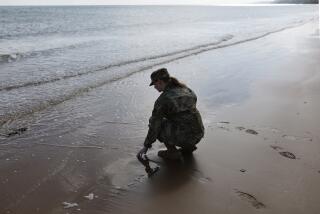What Did You Do During World War II, Grandpa?
- Share via
Recently my grandson asked me, “What did you do in the war?” I told him that I was in the Coast Guard and one of my duties was landing Marines on the beaches of several islands in the Pacific theater of operations.
Then it occurred to me that somehow down through the 40-some years since World War II ended there has been very little told or written about the amphibious forces. We’ve all heard and seen many films and tales of the Marines and soldiers who waded ashore on these islands, but not much has been said about us guys who brought them from the troopship to the beach.
Most troops only had to hit the beach one time on D-Day. Sometimes we made anywhere from five to 10 trips from the ship to the beach. Our LCVPs, otherwise known as Higgins boats, were 36 feet long and designed to carry either 36 troops or one Jeep and five or 10 men.
In heavy seas it was no picnic getting those people off the landing nets and into the boats. Many times the boats were slammed into the side of the mother ship with such force that they would sink on the spot with heavy casualties.
My ship was the USS Leonard Wood (APA-12) and was crewed entirely by U.S. Coast Guard personnel. She started with the first landings in North Africa, through Anzio in Italy, and then into the Pacific Theater where she participated in most of the major landings from the Marshall islands and on to the Marianas and the Philippines.
We carried mostly troops of the Second, Fourth and Fifth Marine Divisions. They were all brave and gallant fighting men, but just once before the memory fades, let’s hear a cheer for those three-man crews (the coxswain, the motor machinist and the gunner) of those Higgins boats who I like to call the “stand-up sailors.”
We weren’t standing up as we hit those beaches because we were brave--we just had to see where the hell we were going!
ROBERT HOON
Camarillo
More to Read
Sign up for Essential California
The most important California stories and recommendations in your inbox every morning.
You may occasionally receive promotional content from the Los Angeles Times.













